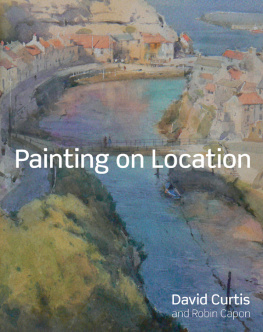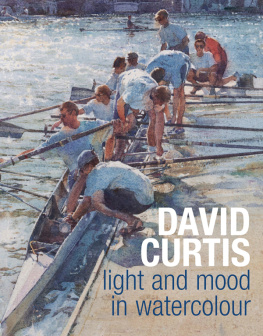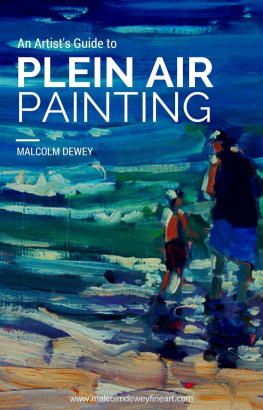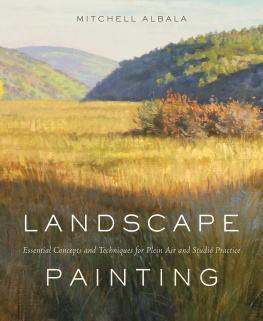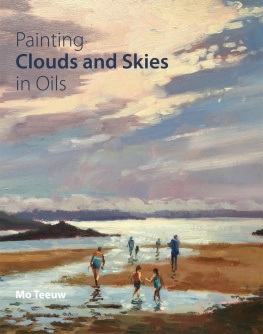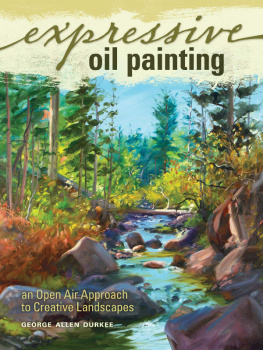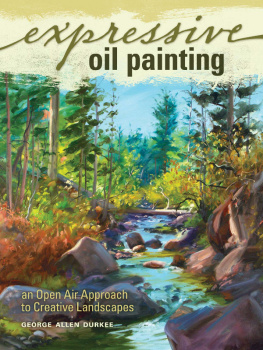Painting on Location

View Through the Copse, Jenkinsons Farm Oil on board 30.5 40.5cm (12 16in)

Morning Low Tide, Staithes Harbour Oil on board 25.5 25.5cm (10 10in)
Painting on Location
David Curtis and Robin Capon

Contents
Introduction
I imagine that we all occasionally reflect on the most satisfying and pleasurable aspects of our life. For me, without doubt, the most fulfilling times are when I am outside in the landscape and have found an inspiring and challenging subject to paint. I have loved painting outdoors since my early teens, when I was given my first oil-painting set as a Christmas present. I soon discovered that oils can be used in a very direct, alla prima manner to capture the essence of a subject and that this approach was ideal for painting en plein air (in the open air).
Since those early days, the vast majority of my work has been based on the plein-air approach. Often I work entirely on site, or I might start a painting on site and finish it in the studio. It is the most rewarding and enjoyable way of working, I think. The advantage of painting outside is simply that you are there, living the subject. In experiencing this heightened awareness of everything, you are able to paint with far greater sensitivity and conviction. In the studio, however, the experience is second-hand: you have somehow to recapture what it was like to be in a location, responding to a subject.
At its best, when painting on location, the work is totally absorbing: there is such a complete focus and intensity of purpose that you become unaware of anything else. And if the final painting captures the original inspiration and concept to a fair degree, the thrill of achievement can be quite sublime!
Of course, there are often added difficulties when painting outside, particularly concerning the light and weather. Naturally, time and comfort are far more limited than when working in the studio. For a beginner, early attempts at plein-air painting can seem very daunting and prove quite disappointing, but give it time and persevere. I know from my own experience that it takes time to build up confidence and develop the necessary aspects of technique and speed of working.

Receding Tide, Staithes Oil on linen canvas 61 76cm (24 30in) I always look for an exciting composition. With these breaking waves, I used a combination of careful observation and invention to create some strong, directional lines leading into the painting.

A Quiet Ride Home oil on board 40.5 30.5cm (16 12in) You dont have to go far to find interesting plein-air subjects. I painted this in the lane near our house.

David Curtis at work.
Even now, after more than 50 years experience, I still have disappointing days occasionally. But the successful days more than compensate for that. What you learn is to accept the disappointments, re-motivate yourself and start a new painting. The more plein-air painting you do, the more you learn about choosing appropriate subjects and how to interpret them in a quick, lively and interesting way. It is important to go out painting as often as you can.
I paint in both watercolours and oils. Both are suitable for plein-air work, although for subjects in which I need to capture a fleeting light effect with speed and control, my preference is for oils. Where the key factor is atmosphere, but accuracy in depicting the shapes isnt quite so vital, I normally choose watercolour. It is good to have a choice of media, I think, because different media can bring out different qualities in a subject. Outside, I quite often start with an oil painting and then move on to work in watercolour, or vice versa.
I also used to work in pastel and pen and ink, and these too are excellent media for making plein-air studies. Incidentally, if you are not confident about starting directly with paint, take your sketchbook and some different sketching materials and begin with some plein-air sketches perhaps later using these as starting points for some small paintings in the studio.
My principal aim in this book is to engender confidence, so that if you have not tried plein-air painting before or are relatively new to the idea, you will be encouraged to make some painting trips and see what you can achieve. The book includes information on all aspects of location painting, from practical considerations and equipment to painting techniques and capturing the essence of a subject. I hope it will help to prepare you for the wonderful painting opportunities that await you outdoors and inspire you to try this increasingly popular way of painting. There is no greater creative experience!
The Great Outdoors

Sheltered Harbour from the Nab, Staithes Oil on board 25.5 25.5cm (10 10in) As time is always a key factor in plein-air work, it is important to have clear objectives for a painting and to stick to them. Here, my aim was to capture the contrasting qualities of texture and light between the transparency and fluidity of the water and the solid, structural nature of the enveloping cliff.
When I started painting seriously, almost 50 years ago now, plein-air painting (painting in the open air) was a popular way of working. You would often see artists working directly from life outside, and this is how I learned to paint, working alongside experienced local artists. I was also lucky enough to paint with Edward Wesson, Jack Merriott and other nationally well-known artists of the time.
Throughout my career I have remained loyal to the plein-air approach and I continue to paint on the spot whenever I can, throughout the year and in all weather conditions. Like many artists, I think this method of painting is the best way to achieve a personal response to a subject. There is more edge and daring with plein-air work; it is a much more challenging way of painting than working in the studio. To quote a modern saying, you get into the zone of the painting experience, and it can be quite spiritual. Equally, when painting outdoors, the surroundings, the weather, the sounds, the atmosphere and the sense of occasion all contribute to the vitality of the whole experience.
Painters and plein-air work
Something I have always admired about many of the great plein-air painters of the past, including Henry Scott Tuke and Stanhope Forbes, is the degree of finish that they managed to achieve. And they did that without having to resort to photographs as back-up reference, as we might do today. Also, they werent afraid to work on a big scale and so have to return again and again to a location until the painting was completed. Today, we can only marvel at their painting ability and at their incredible powers of observation and draughtsmanship. The immense skill and fluency of their work remains an inspiration.
Next page
